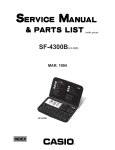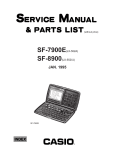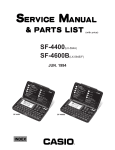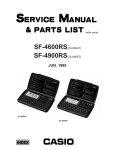Download Casio SF-A7 Specifications
Transcript
(with price) SF-4300R(LX-546) OCT. 1994 SF-4300R R CONTENTS 1. SCHEMATIC DIAGRAM .................................................................................................... 1 1-1. MAIN PCB .................................................................................................................. 1 1-2. KEY MATRIX ............................................................................................................. 2 2. SPECIFICATIONS ............................................................................................................. 3 3. TO REPLACE THE BATTERIES....................................................................................... 5 4. DATA TRANSFER ............................................................................................................. 6 5. OPERATION REFERENCE ............................................................................................. 10 5-1. RESET OPERATION ............................................................................................... 10 5-2. TO ADJUST THE DISPLAY CONTRAST ............................................................... 11 5-3. TO CHECK THE MEMORY STATUS ...................................................................... 11 5-4. THE SOUND MENU ................................................................................................. 11 6. LSI, IC (Pin function) ...................................................................................................... 12 6-1. CPU .......................................................................................................................... 12 6-2. RAM:MB84256A-70/10LL (LSI3), ROM:µPD23C1001EAGW-K81 (LSI4) ............. 13 6-3. VOLTAGE REGULATOR:S-81253SGUP (REG1) .................................................. 14 6-4. VOLTAGE DETECTOR:S-80752AN (DET1) ........................................................... 14 7. TROUBLESHOOTING ..................................................................................................... 15 8. HARD CHECK ................................................................................................................. 18 9. ASSEMBLY VIEW ........................................................................................................... 23 10. PARTS LIST .................................................................................................................... 25 1. SCHEMATIC DIAGRAM 1-1. MAIN PCB —1— 1-2. KEY MATRIX —2— 2. SPECIFICATIONS Main Modes: Telephone Directory, Memo, Schedule Keeper, Reminder, Calendar, Home Time, World Time and Calculator. Data storage: Storage and recall of telephone, memo, schedule, reminder data; calendar display; secret area; editing; memory status display. Clock: World time; reminder alarm; schedule alarm; daily alarm; accuracy under normal temperatures: ±3 seconds average. Calculation: 10-digit arithmetic calculations; arithmetic constants (+, –, ×, ÷); independent memory; percentages; square roots; 20-digit approximations; date calculations; other mixed calculations. General: Display element: 16-column × 4-line LCD Memory capacity: 32 KB (28579 bytes) Main component: LSI (The LX-546AQ is with an outside ROM, LSI4.) Power supply: 2 lithium batteries (CR2032) Power consumption: 0.05W Battery life: Approximately 400 hours continuous operation in Telephone Directory Approximately 350 hours repeating one minute of input and 10 minutes of display in Telephone Directory Approximately 12 months for memory back up Auto power off: Approximately 6 minutes after last key operation Operating temperature: 0°C ~ 40°C (32°F ~ 104°F) Dimensions: Unfolded: 9.6H × 122W × 158.5Dmm (3/8"H × 4 3/4"W × 6 1/4"D) Folded: 12.4H × 122W × 81.5Dmm (1/2"H × 4 3/4"W × 3 1/4"D) Weight: 89g (3.1 oz) Current consumption: Power switch TYP. [µA] MAX [µA] OFF — 20 ON — 550 Storage Capacity: The 32K bytes memory capacity includes a 28579 bytes user area. The following shows examples of what this means for the storage of data in each mode. Telephone Directory: Approximately 1360, under the following conditions: Approximately 680, under the following conditions: Memo: Approximately 1290, 20-character memos —3— 8-character name 10-character telephone number 8-character name 10-character telephone number 20-character address Schedule Keeper: Approximately 890, under the following conditions: 1 item per day, 20 characters per item 30 days per month Starting time specified, alarm time set Approximately 1020, under the following conditions: 1 item per day, 20 characters per item 30 days per month Starting time specified, no alarm time Reminder: Approximately 1680, under the following conditions: 10 characters per item Alarm time set Approximately 1900, under the following conditions: 10 characters per item No alarm time —4— 3. TO REPLACE THE BATTERIES Screw 1) Loosen the screw on the back of the SF-4300B that holds the battery compartment cover in place, and remove the cover. 2) Loosen the screw that secures one of the two battery holders in place and remove the battery holder. RESET Caution Be sure to remove only one battery at a time. Otherwise, you will lose all data stored in memory. 3) Replace the old battery with a new one, making sure that the positive (+) side of the new battery is facing up (so you can see it). 4) Replace the battery holder and secure it by tightening its screw. • Be careful that you do not over tighten the screw. 5) Repeat steps 2) through 4) for another battery. • Be sure to replace all two batteries. Never mix old batteries with new ones, and be sure to use CR2032 lithium batteries only. 6) After you replace all two batteries, replace the battery compartment cover and secure it by tightening its screw. • Be careful that you do not over tighten the screw. —5— 4. DATA TRANSFER SF-4300R can transfer customers data to other SF-4300R with memory protection only when replacing the LCD or the outer case. How to transfer the data. * Before connecting the cable (SB-60/62), be sure to reset the slave machine to clear all data. 1) Turn off the power switch and connect the two units using the cable (SB-60/62) as shown in the drawing. SB-60/62 accessory cable 2) Turn on the power switch of each machine. 3) The slave machine must be set the date of Feb. 3rd, 1901 into the memory under the calculator mode. Operation: 1. Press ON MENU 2. Select "CAL" mode or press 6. 3. 1 TIME DATE TIME DATE 2 M 3 TIME DATE M+ R SUN 1901/ 2/ 3 If you don't set the date, the "PASSWORD" isn't transferred to the slave machine. —6— Setting up for Data Communications The following procedures describe what you should do to set up for data communications between two SF Units or between an SF Unit and a personal computer. In addition to hardware connections, it details how to set up the communications parameters and how to set up the SF-4300R to receive data. By following these instructions carefully, you can be ensured of successful communications every time. To connect two SF Units 1. 2. 3. Check to make sure that the power of the two SF Units is switched off. Remove the covers from the connectors on the two SF Units. Connect the two SF Units using the optional SB-60/62 cable. You can also connect them using an SB-60/62 cable. Important Be sure to replace the connector covers on the SF Units when you are not performing data communications. 4) Check the hardware parameters. 1. Select "TEL" mode or press 1 under MENU screen. 2. Press FUNC twice to display the second function menu. FUNC FUNC 1* 2 3 4 TO SECRET AREA ALL DELETE LABEL EDIT DATA COMM * If the password isn't registered in the SF unit, display shows X instead of "1". CAPS • You can perform the above operation while the initial screen of the Memo Mode, Schedule Keeper, Calendar, or Reminder is displayed also. 3. Press 4 to select DATA COMM. 4 1 2 3 SEND RECEIVE SET UP PAR. CAPS 4. Press 3 to select SET UP. 3 ✻✻ SET UP PAR. ✻✻✻ PARITY E O N BIT LENGTH 7 8 BPS 4800 9600 CAPS —7— • N is blinking. 5. If the units have another condition, reset as above. • To change the parameters 1. 2. 3. SET 5) Use the and — cursor keys to change the selected parameter on the display. Use the and cursor keys to change the high-lighted setting of the currently selected parameter. Press SET to store them in memory. Set up the slave machine 1. While an initial screen is displayed, press FUNC twice to display the second function menu. FUNC FUNC 1* 2 3 4 TO SECRET AREA ALL DELETE LABEL EDIT DATA COMM * If the password isn't registered in the SF unit, display shows X instead of "1". CAPS • You can perform the above operation while the initial screen of the Memo Mode, Schedule Keeper, Calendar, or Reminder is displayed also. 2. Press 4 to select DATA COMM. 4 1 2 3 SEND RECEIVE SET UP PAR. CAPS 3. Press 2 to select RECEIVE. 2 DATA RECEIVE OK TO STOP PRESS (ESC) CAPS 6) Set up the customer’s machine. 1. While an initial screen is displayed, press FUNC twice to display the second function menu. FUNC FUNC 1* 2 3 4 TO SECRET AREA ALL DELETE LABEL EDIT DATA COMM * If the password isn't registered in the SF unit, display shows X instead of "1". CAPS • You can perform the above operation while the initial screen of the Memo Mode, Schedule Keeper, Calendar, or Reminder is displayed also. —8— 2. Press 4 to select DATA COMM. 4 1 2 3 SEND RECEIVE SET UP CAPS 3. Press 1 to select SEND. 1 1 2 3 ONE ITEM MODE DATA ALL DATA - SEND - CAPS 4. Press 3 to select ALL DATA. 3 SEND ALL DATA? SET/ESC CAPS 5. Press SET to start the send operation or ESC to abort the operation without sending anything. SET or ESC DATA SENDING TO STOP PRESS (ESC) CAPS • Data is send in the sequence: Telephone Directory, Memo Mode, Reminder Mode, Schedule Keeper, Calendar. • To abort the send operation at any time, press ESC. • If an error occurs during the send operation, the message “TRANSMIT ERROR!” appears on the display. Press ESC to clear the error message. 6. After the send operation is complete, the display returns to the initial screen of the mode you were in when you started this procedure. —9— 5. OPERATION REFERENCE 5-1. RESET OPERATION The following procedure erases all data stored in the memory of the SF Unit. Perform the following operation only when you want to delete all data and initialize the settings of the SF Unit. Remember-you should always keep copies of important data by writing it down, by transferring it to a personal computer or other SF Unit. To reset the SF Unit's memory RESET button RESET 1. Switch on power and press the RESET button with a thin, pointed object. ALL DATA CLEAR! OK? Y/N CAPS Warning! The next step deletes all data stored in the SF Unit's memory. Make sure that you really want to delete the data before you continue! 2. Press Y* to reset the memory and delete all data or N to abort the reset operation without deleting anything. * Note that the letter key you press to indicate "yes" depends on the system language, as noted below. Czech: A Polish: T English: Y Spanish: S Portuguese: S Russian: Y Hungarian: I Following the reset operation described above, the Home Time display appears and the SF Unit setting are initialized as noted below. Home Time: Zone: World Time: Daily Alarm: Menu Mode: Language: 12-hour format JAN/1/1994 AM/12:00 00 London(LON) New York(NYC) 12:00 PM Telephone mode English Schedule alarm → ON Reminder Alarm → ON Daily alarm → OFF Key → ON Character input: CAPS Sound: — 10 — 5-2. TO ADJUST THE DISPLAY CONTRAST 1 Enter the Telephone Directory Mode. • You could enter any mode except the Calculator mode here. 2 Press SHIFT and confirm that the "S" indicator is on the display. 3 Press CONT. 4 Use the and keys to adjust the contrast. ✻✻✻✻ CONTRAST ✻✻✻✻ (LIGHTER) (DARKER) CAPS 5 After you are finished, press ESC to clear the contrast adjustment display. 5-3. TO CHECK THE MEMORY STATUS Hold down SHIFT CAPA to display a screen that shows the current memory status. To clear the memory status display, release CAPA. Remaining memory capacity ✻✻✻✻ CAPACITY ✻✻✻✻ FREE 27678 USED 901 3% CAPS Total number of characters stored in memory 5-4. THE SOUND MENU The sound menu lets you switch the key input tone and the various alarms of the SF Unit on and off. Flashing dot indicates currently selected item SCHED AL REMINDER DAILY AL KEY ● ON ● ON ON ● ON OFF OFF ● OFF OFF CAPS Dot indicates on/off status The on/off status of each SOUND menu items is indicated by a dot, and the dot that is flashing on the menu is the one that is currently selected. Use and to change the currently selected (flashing) item. Use and to switch the currently selected item on and off. — 11 — 6. LSI, IC (Pin function) 6-1. CPU No.1 Pin No. 1~5 Signal C0 ~ 4 I/O Out Function Common Signal for display 6 GND In GND /0[V] 7,8 BZ1,2 Out 9 VDD In 10 CSRA1 Out Chip enable signal (Not used) 11 CSRA2 Out Chip enable signal for RAM 12 CSROM Out Chip enable signal for ROM (only used in LX-546AQ) 13 WEB Out Write enable signal for RAM Buzzer terminal Power supply/5.3[V] 14,15 RA15,16 Out Address bus for ROM (only used in LX-546AQ) 16 ~ 30 A0 ~ 14 Out Address bus 31 ~ 38 IO0 ~ 7 I/O Data bus 39 ~ 54 KY0 ~ 15 I/O Key signal 55 SW In Battery switch (On: "L"/0[V] 56 DEBUG - Test for manufacturer 57 ON 58 CRCKI In 59 SOUTB Out 60 SIN In Transmission data input 61 VDD In Power supply/5.3[V] 62 TEST - Test for manufacturer 63 VTM - Not used Out Data communication enable GND/0[V] Transmission data output — 12 — Off: "H"/6[V]) Pin No. 64,65 67,69~71 Signal I/O OSC I/O I/O V1 ~ 4 Function Clock terminal (DT-26S) Voltage for LCD driver OFF: 0[V] ON: 68 NC - Not used 72 INTO In Low battery detection 73 STNT - GND/0[V] 74 VLCD In Power supply/5.3[V] 0.64(Light) ~ 1.29(Dark)[V] V2: 1.29 ~ 2.56 [V] V3: 3.99 ~ 2.71 [V] V4: 4.64 ~ 3.99 [V] INTO<5.2[V]=> No power on 75 ~ 171 S0 ~ 95 Out Segment signal for display 172 ~ 199 C5 ~ 32 Out Common signal for display 168, 200 NC - V1: Not used VSS IO0 IO1 IO2 11 12 13 VCC WE A13 A8 A9 A11 OE A10 CS IO7 IO6 IO5 IO4 IO3 28 27 26 25 24 23 22 21 20 19 18 17 16 15 CPU (WEB) ADDRESS BUS A14 A12 A7 A6 A5 A4 A3 A2 A1 A0 IO0 IO1 IO2 GND A13 A8 A9 A11 A10 CPU (CSRA2) IO7 IO6 IO5 IO4 IO3 A0 ~ A14 : IO0 ~ IO7 : WE : CS : OE : Address input signal Data signal (Input/Output) Write enable signal Chip select signal Output enable signal 13 14 15 16 VPP A16 A15 A12 A7 A6 A5 A4 A3 A2 A1 A0 IO0 IO1 IO2 GND VCC PGM NC A14 A13 A8 A9 A11 OE_ A10 CE_ IO7 IO6 IO5 IO4 IO3 32 31 30 29 28 27 26 25 24 23 22 21 20 19 18 17 A14 A13 A8 A9 A11 A10 CPU (CSROM) IO7 IO6 IO5 IO4 IO3 VSS — 13 — DATA BUS IO0 IO1 IO2 1 2 3 4 5 6 7 8 9 10 11 12 ADDRESS BUS RA16 RA15 A12 A7 A6 A5 A4 A3 A2 A1 A0 µPD23C1001EAGW-K81 ROM: µPD23C1001EAGW-K81 (LSI 4) ADDRESS BUS DATA BUS 1 2 3 4 5 6 7 8 9 10 DATA BUS DATA BUS ADDRESS BUS A14 A12 A7 A6 A5 A4 A3 A2 A1 A0 MB84256A-70/10LL 0.1µ 6-2. RAM: MB84256A-70/10LL (LSI 3) A0 ~ A16 : IO0 ~ IO7 : OE_ : CE_ : Address input signal Data signal (Input/Output) Output enable signal Chip enable signal 6-3. VOLTAGE REGULATOR: S-81253SGUP (REG1) Output Voltage (Vout): 5.3V ± 5% VIN 2 3 OUT RA + – RI RB VREF 1 2 3 GND Vin Vout GND 1 6-4. VOLTAGE DETECTOR: S-80752AN (DET1) Detection Voltage(–VDET): 5.2V ± 2.5% [5.07 V (MIN) ~ 5.33 V (MAX)] 2 VDD 1 OUT 1 2 3 Vout Vin GND 3 VSS VDD +VDET –VDET VDD VDD VSS — 14 — Input voltage Output voltage >5.2 V 5V <5.2 V 0V 7. TROUBLESHOOTING < No power on > N Adjust contrast Is contrast adjustment OK? Y N Replace batteries Is power of batteries enough? Y Y Does display appear by pressing Reset button? Check other function N Y Does it sound by key enter? Refer to <No/Erratic display> N Do batteries make positive contact with the battery springs? N Adjust contact and clean battery spring Y Y Is 3-pin of S-81253 (REG1) 5.3 [V]? N N Are capacitor C8, C9, C10, C11,C12 OK? Replace C8, C9, C10, C11,C12 Y Replace REGT1 1 — 15 — 1 N Replace DET1 Is 1-Pin of S-80752AN (DET 1) 5[V]? Y N Is 11-Pin of CPU (LSI 1) sending the signal? Replace CPU (LSI1) Y N Is 13-Pin of CPU (LSI1) sending the signal? Replace CPU (LSI1) Y N Does RAM or ROM (for LX-546AQ) make positive contact with PCB? Resolder RAM (LSI3) or ROM (LSI4) Y Replace RAM (LSI3) or ROM (LSI4) or CPU (LSI1) < No key input > Does key make positive contact with PCB Ass’y N Replace PCB Y Does CPU make positive contact with PCB? Y Replace CPU (LSI1) — 16 — N Resolder CPU (LSI1) < No/Erratic display > N Is input 2-Pin of S-81253 (REG1) 6[V]? Check batteries Y N Is output 3-Pin of S-81253 (REG1) 5.3[V]? Replace REG1 Y *Are voltage of several capacitors enough? V1: V2: V3: V4: N 1.3 [V] 2.5 [V] 2.7 [V] 3.9 [V] Y Check solder part of C6, C7, C8, C9, C10 or replace. *CONTRAST: MAX N Does CPU (LSI1) make positive contact with PCB? Resolder Y Replace CPU (LSI1) < High current consumption > Y Is there any short circuit? Check PCB N N Replace capacitors Are the several capacitors OK? Y Resolder/Replace CPU, IC — 17 — 8. HARD CHECK No. OPERATION DISPLAY 1 Turn on while short the short pad (KEY61). SELF TEST PROG. PRESS SEARCH QUIT BY OFF CASIO AUG. 1993 SEARCH 3 Main menu 1 DISP MEMORY KEY BUZZER I/F DISP 1 WHITE 2 BLACK 3 CHECK. 4 5 6 7 RVS. FRAME DOT 4 TIME Display check 1 4 No display 2 5 All dots display 3 6 Checker display 4 7 The short pad is located behind the tape I. 2 3 4 5 TEST MENU 2 1 NOTE Reverse checker display — 18 — No. OPERATION DISPLAY NOTE 5 8 FRAME 6 9 Dots appear at 4 corners. TIME DISPLAY 10 7 Check if timer is working. 00:00:00 ESC TEST MENU 11 1 DISP 12 3 13 2 HOME/WORLD MENU OFF ON INS DEL TIME/DATA DISP CHNG KEY 2 3 4 5 MEMORY KEY BUZZER EXT 1 RANDOM 2 AUTO Key check No display 00 01 02 03 04 ............... ............... 14 ESC ......................... FUNC ...................... P CAPS ...................... SET SHIFT ...................... SPACE — 19 — 56 57 • Check the key No. appears on the display. • Check the key sounds. • To return to the menu mode, enter SEARCH . No. OPERATION SEARCH 15 DISPLAY TEST MENU 2 3 4 5 1 DISP 4 BUZZER MEMORY KEY BUZZER EXT 1 BEEP 2 ALARM1 3 ALARM2 16 NOTE Buzzer check 2 EXECUTING!! 17 ESC BUZZER 1 BEEP 2 ALARM1 3 ALARM2 ESC TEST MENU 2 3 4 5 MEMORY KEY BUZZER EXT 3 4 5 6 WR2 READ2 DUMP CHKSUM 18 19 1 DISP 2 MEMORY 1 WR1 2 READ1 20 1 21 WRITE1 — 20 — Check the alarm 1 sound. RAM check No. OPERATION (After few seconds) 22 DISPLAY MEMORY 1 WR1 2 READ1 2 3 4 5 6 NOTE WR2 READ2 DUMP CHKSUM EXECUTING 23 COMPLETE 32KB 24 MEMORY ESC 25 1 WR1 2 READ1 5 ESC 27 TEST MENU 1 DISP 28 WR2 READ2 DUMP CHKSUM $ 00001, 00002, 00004, 00008 00010, 00020, 00040, 00080 00100, 00200, 00400, 00800 01000, 02000, 04000, 08000 10000 26 ESC 3 4 5 6 Press "RESET" key. — 21 — 2 3 4 5 Check sound. If RAM has defect, error message will be appered. MEMORY KEY BUZZER EXT The address of ROM (LSI4) should be appeared. (Only for LX-546AQ) — 23 — 9. 16 ASSEMBLY VIEW 25 17 10 6 7 12 JC1 27 27 X1 8 19 LSI 11 3 23 9 15 22 4 c11 c9 1 20 21 29 28 26 24 13 18 2 14 5 10. PARTS LIST N Item N N 5 5 N N N N N N N N N N N N N C1~4,C7 C13 C5,6 C8,10,12 C9,11 D1 D2 DET1 JC1 LSI1 LSI1 LSI3 LSI4 Q1 R10 R12 R13 R3,20 R4,20 R5 R6 R7 R8,9 REG1 X1 1 2 3 4 6 7 8 9 10 11 12 13 14 15 16 17 18 19 20 21 Code No. Specification Parts Name A : LX-546AQ (With an outside ROM) B : LX-546AR (Without outside ROM) FOB Japan Quantity M N.R.Yen R A B Unit Price PCB ASS'Y 6413 3140 PCB ass'y DB20BX0300S 6413 3200 PCB ass'y DB20BX0301Q (The two assemblies contain the following available elements.) 6510 4890 Chip capacitor CP001A332T2 6511 7560 Chip capacitor CP001A432T8 6510 5000 Chip capacitor CP018F602T1 6511 7560 Chip capacitor CP001A432T8 2803 6813 Capacitor CB0011341R3 2390 2135 Diode BC20MA740T0 6510 4940 Diode BC10MA71307 2105 3297 CMOS IC S-80752AN-JG-T1 3501 6538 Jack HSJ1169-012010 6411 2051 COB LSI C312133A*2 6412 6571 COB LSI C312133A*8 2011 6972 LSI (RAM) MB84256A-70/10LL 2011 9156 LSI (ROM) µPD23C1001EAGW-K81 6510 4760 Transistor BBX114YT103 6410 9500 Chip resistor CC4703D11T3 6511 7470 Chip resistor CC1003311C9 6510 4850 Chip resistor CC2005311C0 6511 7440 Chip resistor CC0000311C3 6511 7440 Chip resistor CC0000311C3 6512 1380 Chip resistor CC1801D11E7 6512 1410 Chip resistor CC0473D11T3 6510 4770 Chip resistor CC1001311C0 6512 1360 Chip resistor CC0012D11T6 2105 3290 Regulator S-81253SGUP-DIJ-T1 6510 4550 Crystal BD0063P2509 3335 4606 LCD CD418-TS 6409 6270 Hot melt film FX200P40056 6409 6300 Battery plate (+) EF01DB20102 6409 6310 Battery plate (–) EF02DB10100 COMPONENTS 3122 2380 Buzzer EFB-S55C41A8 6413 3210 Lower cabinet FABDB201021 6409 6210 Battery change label HGC00001102 6510 4440 Nut tape HGFC0001206 6510 4500 Buzzer tape HGFC0000501 6512 1080 Nut MD100000602 6408 5920 Switch knob ass'y DB2AXX4A00M*1 6409 6220 Battery cover FADDB201001 6409 6230 Battery cover label HGC00001102 6409 6120 Battery holder ECDB1011108 6413 3160 PC sheet EL5G0009409 6409 6140 Push button FB3DB201001 6409 6150 Overlay mylar EL4C0001105 6409 6160 Mask tape HGG00012808 6409 6170 Rubber sheet LADB2010001 6413 3170 Upper cabinet FAADB201016 Notes: N – New parts R–A: M – Minimum order/supply quantity B: R – Rank C: X: — 25 — 1 0 0 1 3,425 3,100 A A 5 1 2 3 2 1 1 1 1 1 0 1 1 1 1 1 1 2 0 1 1 1 2 1 1 1 1 2 2 5 0 2 3 2 1 1 1 1 0 1 1 0 1 1 0 1 0 2 1 1 1 2 1 1 1 1 2 2 14 7 9 7 22 50 53 47 56 970 970 510 320 27 5 5 2 6 6 3 3 5 3 60 55 350 82 16 16 C C C C C C C B C A A B B B C C C C C C C C C B B A A C C 1 1 10 36 1 1 5 100 1 1 20 7 3 3 20 6 1 1 20 17 3 3 20 13 1 1 20 30 1 1 20 29 1 1 20 16 1 1 20 26 1 1 5 75 1 1 20 13 1 1 10 27 1 1 20 7 1 1 1 200 1 1 1 160 Essential Stock recommended Others No stock recommended C X X X X X C X X X C X X X C C 20 20 20 20 20 5 5 10 5 1 1 1 1 20 20 20 20 20 20 20 20 20 20 5 5 1 5 20 20 N Item Code No. N 22 23 24 25 26 27 28 29 6413 3180 6510 4310 6510 4350 6511 7160 6511 8400 6512 0980 6413 3220 6413 3230 N N Notes: Specification Parts Name Sponge cushion Screw Screw RB insert Rubber sheet Screw Hard case Label FH100027507 MAA80006311 MAA80006302 LC120000102 LADB0220105 MAB20086306 FC1DB201023 HGG00014908 N – New parts M – Minimum order/supply quantity R – Rank — 26 — A : LX-546AQ (With an outside ROM) B : LX-546AR (Without outside ROM) FOB Japan Quantity M N.R.Yen R A B Unit Price 2 2 20 15 X 2 2 20 3 C 1 1 20 2 B 1 1 20 17 B 1 1 20 10 C 8 8 20 2 X 1 1 5 88 X 1 1 1 120 X R–A: B: C: X: Essential Stock recommended Others No stock recommended MA0100451A






























